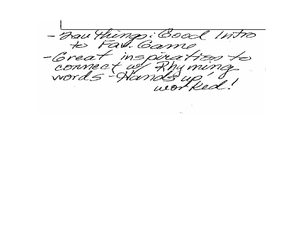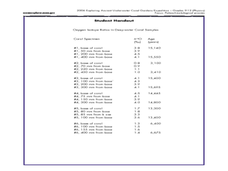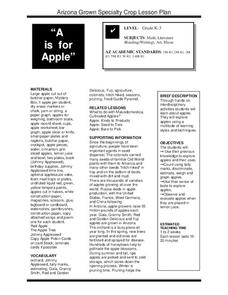University of Minnesota
Beautiful Brain: Do You See What I See?
Can art play tricks on your eyes, and can a still painting really appear to vibrate? The second lesson plan in a four-part series discusses the way our beautiful brains translate visual images. It highlights the style of optical art and...
Curated OER
US Geography, The Blues
This lesson enables teachers to use blues styles and performers to think about various geographical regions of the United States. By studying different blues styles from the Mississippi Delta, Texas, and the Piedmont region of the...
Curated OER
Solving Systems using Elimination
Using elimination to find the point of intersection of two lines, students learn to solve systems of equation. They graph their solutions and use the TI to verify the solution.
Curated OER
My Time Book
First graders write a time book. In this writing and telling time lesson, 1st graders learn about the concept of time using a Judy clock. Students read a book about a ladybug and look closely at the time on the clock. Students then...
Curated OER
Learning Through the Duke
Students examine the contributions of Duke Ellington to the field of jazz. They create an original poem using popular vocabulary from the 1920s, listen to the book, "Duke Ellington," and paint a picture while listening to music by Duke...
Curated OER
The Blues . Music Education
In this lesson students will learn about finding the blues in a variety of musical styles. They will investigate instances of the blues form heard in mainstream pop music, along with exploring the musical styles of two new artists who...
Curated OER
Creating a Midpoint Quad
Using a TI Navigator to drag quadrilaterals around to create different shapes, students learn how to draw midpoints in their quadrilaterals. In this geometry instructional activity, students solve problems using the properties of...
Curated OER
Mandalas, Polygons and Symmetry
Students create a geometric pattern using mandalas, polygons and symmetry. In this geometry lesson, students analyze the mathematics involved in making the mandalas, including the shapes and symmetry. Students create their own mandalas...
Curated OER
Ranging the Triple M's
Fifth graders explore collecting and analyzing data. In this mean, median and mode lesson, 5th graders use real word data to determine the mean, median and mode. Students are given sets of numbers on index cards as asked to find the...
Curated OER
Measure It Up!
Students investigate the states that water may take. In this physical science lesson, students read the book, Water: Up, Down, and All Around and recall the states of water from the book. Students examine how water takes the shape of its...
Curated OER
Roofing and Right Triangles
Students use models and symbols to represent properties of the Pythagorean Theorem. In this right triangle lesson, students connect real jobs to properties of right triangles. They solve word problems applying the correct ratios and...
Curated OER
Classroom Builder
Learners explore music theory by discussing a classic song. In this musical notation lesson, students listen to the song "My Favorite Things" and discuss and share their personal tastes with the class. Learners practice writing notes on...
Curated OER
It's the Law
Students explain various scientific laws used in SCUBA diving. For this theory based lesson, students examine and explain how temperature, density, and salinity relate to SCUBA diving using various scientific laws to engage their learning.
Curated OER
Shapes and Introduction to Geometry
Students make a quilt. In this geometry lesson, students discuss patchwork quilts and learn some different geometric shapes and patterns that are commonly used. Students explore designs with triangles and squares and then make their own...
Curated OER
Sonar Simulation
Young scholars compare and contrast side-scan sonar to other methods used to find objects underwater. In this underwater search lesson, students describe side-scan sonar and make inferences about the topography of an unknown landscape....
Curated OER
The Census of Marine Life
Students explain diversity and abundance in marine life. In this oceanic biology lesson, students collect information for various geographical areas to collect a census of marine life.
Curated OER
How can deep-water corals be used to determine long-term patterns of climate change?
Students explore the concept of paleoclimatological proxies. In this paleoclimatological proxies lesson, students explain isotope ratios in deep water coral samples. Students write a paragraph about global climate change as...
Curated OER
Keeping Watch on Coral Reefs
High schoolers investigate the dangers Coral Reefs face by investigating satellite images. In this environmental protection lesson, students utilize the Internet to discover the types of satellites and sensors used to provide...
Curated OER
Local History: Mapping My Spot
Students explore maps to discover historical information about their local area. In this mapping and history instructional activity, students use panoramic maps of their own town/city to interpret historical information. ...
Curated OER
Find The Best Car
Consider how to use consumer reports to review performance, price, reliability and safety information about specific cars. Young learners review how life styles and economics affect car choices. They then find solutions for car-buying...
Curated OER
A is for Apple
Students participate in a variety of activities to learn about apples. Students graph apples, learn about apple uses, taste apples, and observe what happens when apples are dipped in lemon juice.
Curated OER
Mathematics: Technology and Connections
Sixth graders interpret and replicate patterns. For this patterns lesson, 6th graders are given an item with a definite pattern which they must replicate using a calculator or computer and then justify how they relate. Students...
Curated OER
A Walk on the West Side
Students comprehend what makes up the physical community. Read and construct scale drawings and models. Explore the history of infrastructures and how the contributions of science, math and industry have led to the development of their...
Curated OER
Poetic Math Greeting Cards
Fourth graders work in groups; collect data in a survey; depict in tables, charts, or graphs the results of the survey; and make predictions. They use creative writing skills and computer skills to generate a greeting card of their own.

























